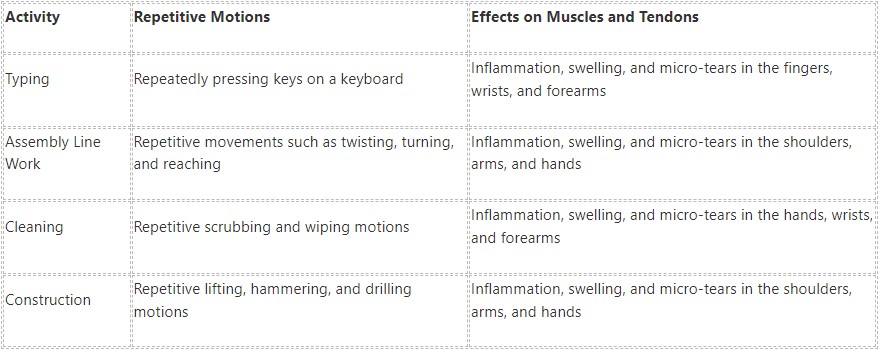In this article, we will explore various causes and solutions for hand pain experienced during writing. We will talk about the anatomy of the hand and discuss the mechanisms of pain and common conditions such as repetitive strain injury, carpal tunnel syndrome, arthritis, and poor writing habits. In the article, we will also assess the importance of rest and recovery, ergonomic solutions, medical interventions, and preventive strategies for maintaining long-term hand health. By understanding the underlying causes and implementing appropriate measures, individuals can alleviate hand pain and enhance their writing experience.
Writing is often romanticized as a creative and fulfilling activity, but the reality is that it can also be painful and uncomfortable. Many writers experience hand and wrist pain, which can significantly impact their productivity and quality of life. Whether it’s typing on a keyboard or gripping a pen, the repetitive motions involved in writing can take a toll on the delicate structures of the hand. Understanding the causes of writing pain and implementing strategies to prevent and manage writers must continue pursuing their passion without sacrificing their well-being.
Key Takeaways
- Writing can be a painful experience for many people.
- Repetitive strain injury is a common cause of writing pain.
- Carpal tunnel syndrome can cause symptoms such as numbness and tingling in the hand.
- Arthritis and joint pain can affect writing ability and cause discomfort.
- Poor writing habits, such as bad posture and grip, can contribute to pain.

The Anatomy of the Hand: Understanding the Mechanisms of Pain
To understand why writing can cause pain, you need to have a basic understanding of the anatomy of the hand. The hand is a complex structure composed of bones, muscles, tendons, and nerves. The bones provide structure and support, while the muscles and tendons allow for movement and dexterity. Nerves transmit signals between the brain and the hand, enabling us to feel and control our movements.
When we write, we engage various muscles in our hands and fingers to control the pen or type on a keyboard. These muscles are connected to tendons, which attach them to bones. The repetitive motions involved in writing can strain these muscles and tendons, leading to inflammation and pain. The nerves in the hand can become compressed or irritated, causing sensations such as numbness or tingling.
Repetitive Strain Injury: A Common Cause of Writing Pain
Repetitive strain injury (RSI) is a condition that occurs when a person performs the same motion repeatedly, causing damage to the muscles and tendons involved. Writers who spend long hours typing or handwriting are particularly susceptible to developing RSI.
The repetitive motions involved in these activities can lead to inflammation, swelling, and micro-tears in the muscles and tendons.

The symptoms of RSI can vary but often include pain, stiffness, and weakness in the affected area. In the case of writing, this pain is typically felt in the hand, wrist, and forearm. If left untreated, RSI can progress and lead to more severe conditions such as carpal tunnel syndrome.
Carpal Tunnel Syndrome: Symptoms, Causes, and Treatments
Carpal tunnel syndrome is a specific type of RSI that affects the wrist and hand. It occurs when the median nerve, which runs through a narrow passageway in the wrist called the carpal tunnel, becomes compressed or irritated. This compression can be caused by swelling or inflammation of the tendons in the wrist.
The symptoms of carpal tunnel syndrome include pain, numbness, and tingling in the thumb, index finger, middle finger, and half of the ring finger. These sensations may worsen at night or after prolonged use of the hand. In severe cases, muscle weakness and atrophy may occur.
Treatment options for carpal tunnel syndrome range from conservative measures to surgical intervention. Resting the affected hand and avoiding activities that exacerbate symptoms is often the first step. Physical therapy or occupational therapy exercises can help strengthen the muscles and improve flexibility. Wearing a wrist splint at night can also alleviate symptoms by keeping the wrist in a neutral position. In more severe cases, surgery may be necessary to relieve pressure on the median nerve.
Arthritis and Joint Pain: How They Affect Writing Ability
Arthritis is a condition that causes inflammation and pain in the joints. Several types of arthritis can affect the hands and wrists, including osteoarthritis and rheumatoid arthritis. Writers with arthritis may experience difficulty gripping a pen or typing on a keyboard due to pain, stiffness, and swelling in their joints.
Osteoarthritis is a degenerative condition that occurs when the protective cartilage in joints wears down over time. This can lead to pain, stiffness, and limited range of motion. Rheumatoid arthritis, on the other hand, is an autoimmune disease in which the body’s immune system mistakenly attacks the joints, causing inflammation and pain.
Managing arthritis-related hand pain involves a combination of medication, physical therapy, and lifestyle modifications. Nonsteroidal anti-inflammatory drugs (NSAIDs) can help reduce pain and inflammation. Physical therapy or occupational therapy exercises can improve joint mobility and strength. Using assistive devices such as ergonomic pens or keyboards can also alleviate strain on the joints.
Poor Writing Habits: How Posture and Grip Can Cause Pain
Poor writing habits can also contribute to hand and wrist pain. Maintaining proper posture while writing is crucial for preventing strain on the hand and wrist. Slouching or hunching over a desk can put unnecessary stress on these structures. Writers should aim to sit up straight with their feet flat on the floor and their shoulders relaxed.
The way we grip a pen or type on a keyboard can also impact our hand health. Gripping too tightly or using excessive force can strain the muscles and tendons in the hand. Writers should aim for a relaxed grip that allows for smooth and fluid movements. Using ergonomic pens or keyboards that promote a natural hand position can also help reduce strain.
Overuse and Fatigue: The Importance of Rest and Recovery
Overuse and fatigue are common culprits of hand and wrist pain among writers. Spending long hours typing or handwriting without taking breaks can lead to muscle fatigue and increased risk of injury. Writers need to listen to their bodies and take regular breaks to rest and recover.
Taking short breaks every 30 minutes to an hour can help prevent overuse injuries. During these breaks, writers should stretch their hands and fingers to relieve tension and improve circulation. Engaging in activities that promote relaxation, such as deep breathing or meditation, can also help reduce stress and tension in the hands.
Ergonomic Solutions: Tools and Techniques to Reduce Pain
Ergonomic tools and techniques can play a significant role in reducing hand and wrist pain among writers. Ergonomic keyboards are designed to promote a more natural hand position, reducing strain on the wrists. These keyboards often have a split design and a cushioned wrist rest to provide support and comfort.
Ergonomic pens are another useful tool for writers. These pens are designed to reduce the amount of force required to write, alleviating strain on the hand and wrist. They often have a larger grip and a cushioned surface for added comfort.
Writers can also benefit from incorporating stretching exercises into their daily routines. Simple exercises such as finger stretches, wrist rotations, and hand squeezes can help improve flexibility and reduce tension in the hand.

Medical Interventions: When to Seek Professional Help
While many cases of hand and wrist pain can be managed with self-care and ergonomic solutions, there are instances where medical intervention may be necessary. If pain persists or worsens despite conservative measures, it’s important to seek professional help.
An occupational therapist can perform a thorough evaluation to determine the underlying cause of the pain and recommend appropriate treatment options. This may include physical or occupational therapy, medication, or in some cases, surgery. It’s important not to ignore persistent or severe pain, as it may indicate a more serious condition that requires medical attention.
Prevention and Maintenance: Strategies for Long-Term Hand Health
Prevention is always better than cure when it comes to hand and wrist pain. Writers can take several steps to prevent pain and maintain long-term hand health. Practicing good posture while writing, taking regular breaks, and using ergonomic tools are all important preventive measures.
In addition to these strategies, regular maintenance is important for keeping the hands healthy. Incorporating stretching exercises into a daily routine can help improve flexibility and reduce tension in the hand. Strengthening exercises, such as grip exercises or using hand grippers, can also help maintain muscle strength and prevent injury.
Overall, writers should prioritize self-care and listen to their bodies. If pain or discomfort arises, it’s important to address it promptly and make any necessary adjustments to prevent further injury. By implementing these strategies, writers can continue pursuing their passion while minimizing the risk of hand and wrist pain. Your first step toward healing and feeling better is to schedule an appointment for a professional evaluation. Schedule an appointment today – complete and submit the request form by the link: https://sportscare-armworks.com/request-an-appointment/. Choose the preferred service and location in the Portland area. If you contact us after business hours, we will get back to you the next business day. We look forward to hearing from you!
Don't let pain or limited mobility hold you back.
Contact us now to schedule your appointment and regain strength through personalized physical therapy sessions. Take charge of your health and well-being today!
Request An AppointmentFrequently Asked Questions
-
What causes hand pain when writing?
Hand pain when writing can be caused by a variety of factors, including repetitive strain injury, carpal tunnel syndrome, arthritis, or poor posture.
-
What is repetitive strain injury?
Repetitive strain injury (RSI) is a condition that occurs when a person performs the same motion repeatedly, causing damage to the muscles, tendons, and nerves in the affected area.
-
What is carpal tunnel syndrome?
Carpal tunnel syndrome is a condition that occurs when the median nerve, which runs from the forearm to the hand, becomes compressed or pinched at the wrist. This can cause pain, numbness, and tingling in the hand and fingers.
-
What is arthritis?
Arthritis is a condition that causes inflammation and pain in the joints. It can affect any joint in the body, including those in the hands and fingers.
-
How can poor posture cause hand pain when writing?
Poor posture can cause hand pain when writing by putting strain on the muscles and tendons in the neck, shoulders, and arms. This can lead to pain and discomfort in the hands and fingers.
-
What can I do to prevent hand pain when writing?
To prevent hand pain when writing, it is important to take breaks frequently, maintain good posture, use ergonomic writing tools, and stretch regularly. If you experience persistent pain, it is important to seek medical attention.

